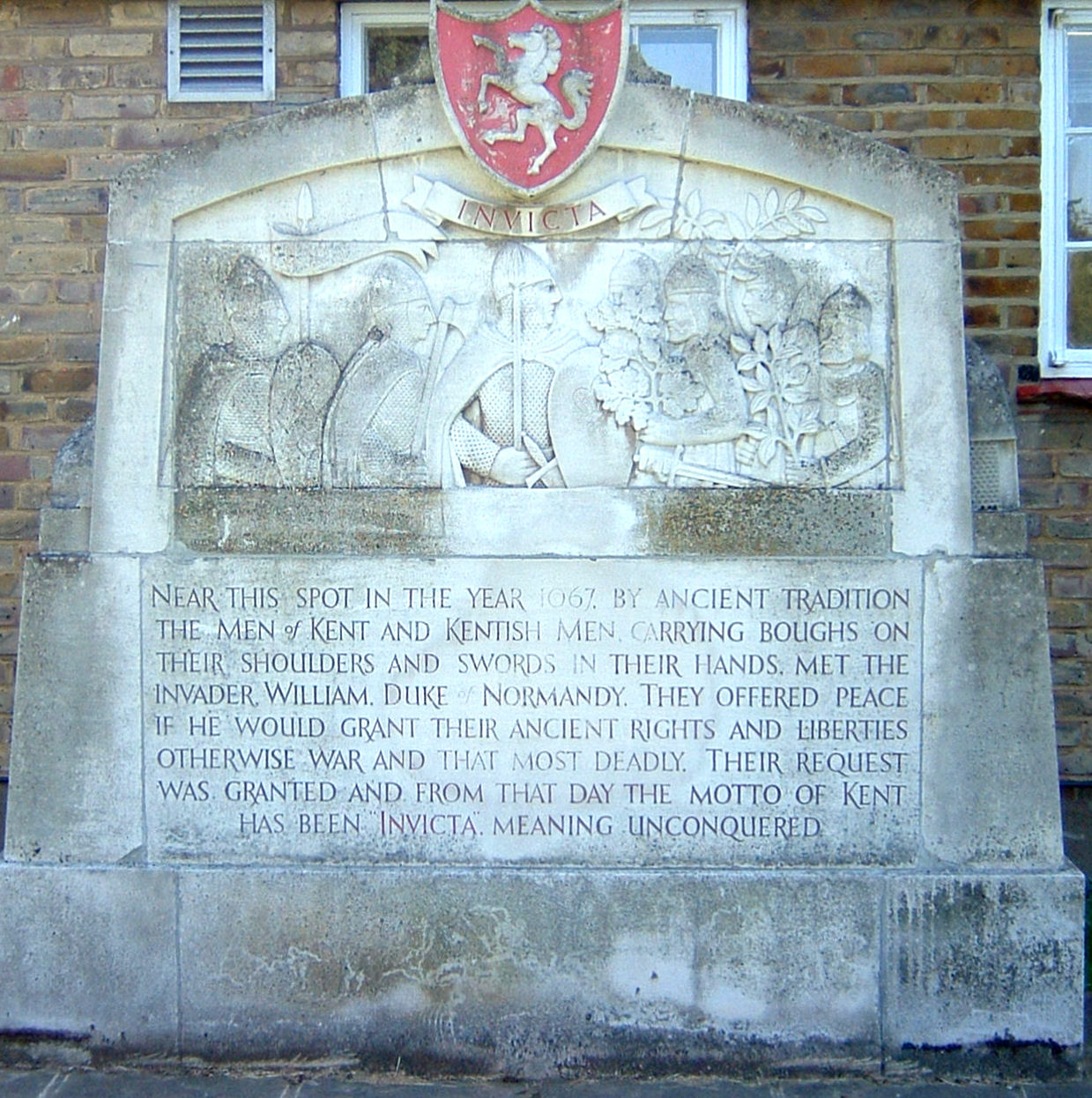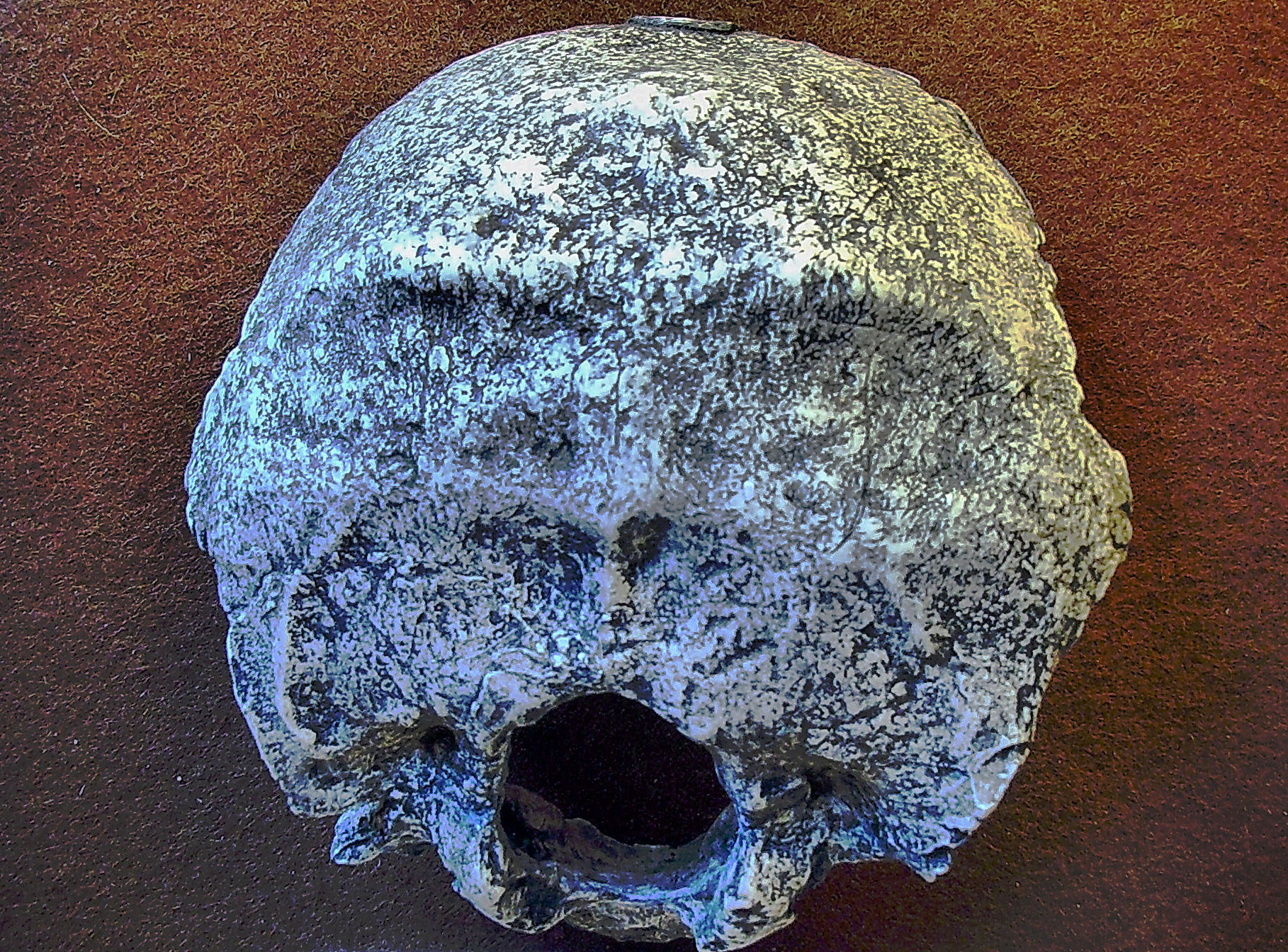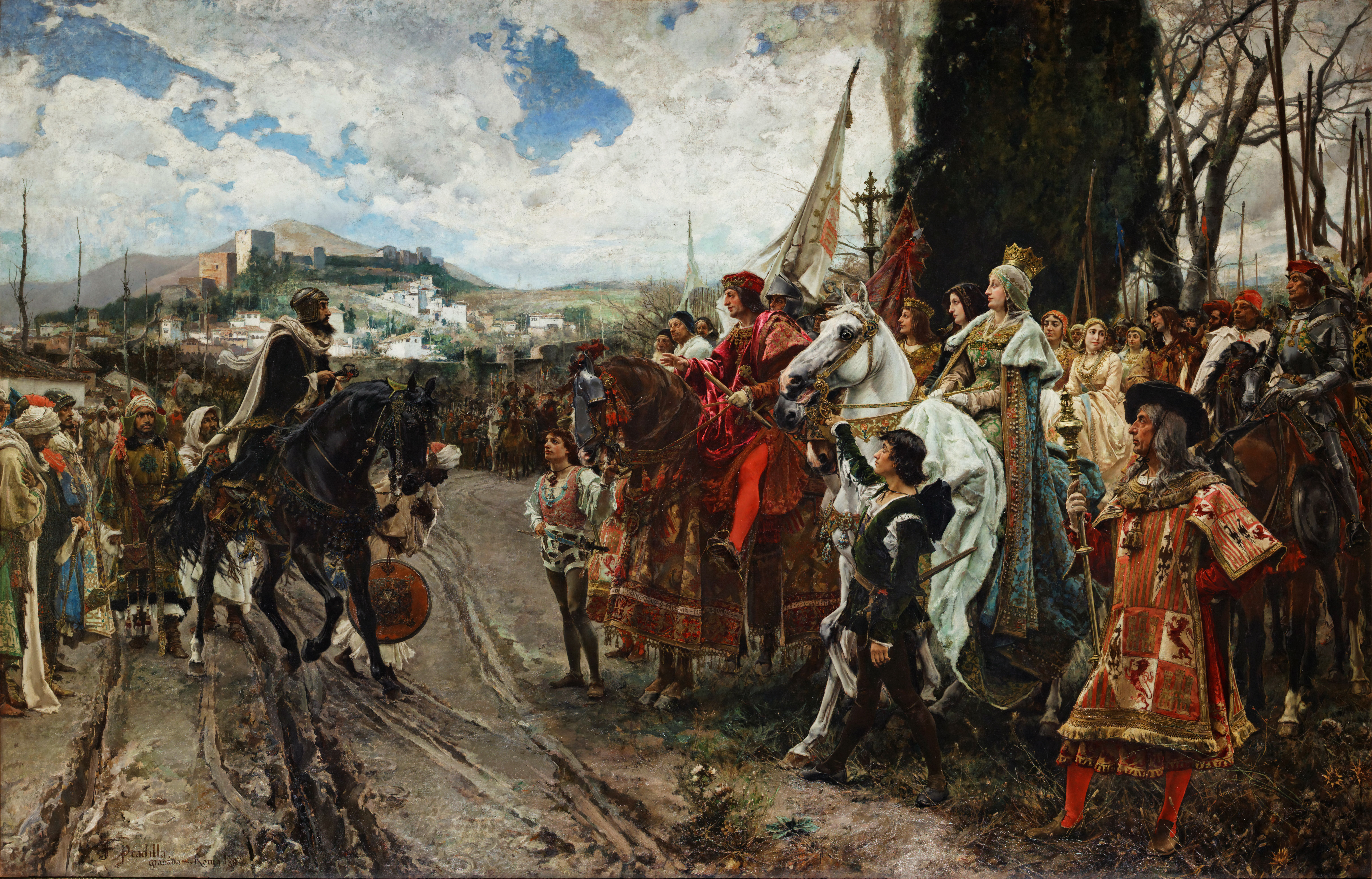|
Invicta (motto)
''Invicta'' is a Latin word meaning undefeated or unconquered. It has been used in mottoes like ''Roma invicta'' (Latin for "Unconquered Rome"), and it is the motto of the county of Kent, England. Theories of origin "''Invicta''" has been a motto for centuries. ''Roma invicta'' is a Latin phrase, meaning "Unconquered Rome", inscribed on a statue in Rome. It was an inspirational motto used until the fall of the Western Roman Empire in 476 AD. This symbolic statement was later printed onto gold coins, to help boost the morale of the failing Empire. For Kent, it dates back to the invasion of England by William the Conqueror. As the official motto, it appears on the coat of arms of Kent County Council. Legend has it that, while marching from the 1066 battle site at Hastings, William marched on to London on his way to the (then) capital Winchester. While passing through Kent, the local people picked up branches and marched at William's men. Scared, William and his army took flight a ... [...More Info...] [...Related Items...] OR: [Wikipedia] [Google] [Baidu] |
Swanscombe
Swanscombe Help:IPA/English, /ˈswɒnzkəm/ is a village in the Borough of Dartford in Kent, England, and the civil parish of Swanscombe and Greenhithe. It is 4.4 miles west of Gravesend and 4.8 miles east of Dartford. History Prehistory Bone fragments and tools, representing the earliest humans known to have lived in England, have been found from 1935 onwards at the ''Barnfield Pit'' about outside the village. This site is now the Swanscombe Heritage Park. Swanscombe Man (now thought to be female) was a late ''Homo erectus'' or an early Archaic humans, Archaic ''Homo sapiens''. According to the Natural History Museum, London, Natural History Museum, however, the remains are those of a 400,000-year-old early Neanderthal woman. The c. 400,000-year-old skull fragments are kept at the Natural History Museum, London, Natural History Museum in London with a replica on display at the Dartford Museum. Lower levels of the Barnfield Pit yielded evidence of an even earlier, more pri ... [...More Info...] [...Related Items...] OR: [Wikipedia] [Google] [Baidu] |
Flag Of Kent
The Flag of Kent is the flag of the English county of Kent. It features the white horse of Kent on a red background, a theme used in several other Kent related coats of arms and logos or symbols. It is sometimes referred to as the Invicta Flag or Invicta Flag of Kent, after the motto of Kent, '' Invicta''. The Flag Institute note, in the flag's entry on the UK Flags Register, that: This is the traditional flag of Kent, supposedly based on that of Horsa, the Jute. Horsa was the brother of Hengest, who founded the Kingdom of Kent in 449. The first recorded reference is in 1605. The flag is an adaptation of the traditional arms of Kent, to which the quote refers. These arms were attributed anachronistically to the Kingdom of Kent, but used by the Justices of Kent for many years. The arms were officially granted to Kent County Council on 17 October 1933 (and re-confirmed to its successor in 1975). The flag was accepted by the Flag Institute as that of the historic county on t ... [...More Info...] [...Related Items...] OR: [Wikipedia] [Google] [Baidu] |
Roman Empire
The Roman Empire ( la, Imperium Romanum ; grc-gre, Βασιλεία τῶν Ῥωμαίων, Basileía tôn Rhōmaíōn) was the post-Republican period of ancient Rome. As a polity, it included large territorial holdings around the Mediterranean Sea in Europe, North Africa, and Western Asia, and was ruled by emperors. From the accession of Caesar Augustus as the first Roman emperor to the military anarchy of the 3rd century, it was a Principate with Italia as the metropole of its provinces and the city of Rome as its sole capital. The Empire was later ruled by multiple emperors who shared control over the Western Roman Empire and the Eastern Roman Empire. The city of Rome remained the nominal capital of both parts until AD 476 when the imperial insignia were sent to Constantinople following the capture of the Western capital of Ravenna by the Germanic barbarians. The adoption of Christianity as the state church of the Roman Empire in AD 380 and the fall of the Western ... [...More Info...] [...Related Items...] OR: [Wikipedia] [Google] [Baidu] |
Porto
Porto or Oporto () is the second-largest city in Portugal, the capital of the Porto District, and one of the Iberian Peninsula's major urban areas. Porto city proper, which is the entire municipality of Porto, is small compared to its metropolitan area, with an estimated population of just 231,800 people in a municipality with only 41.42 km2. Porto's metropolitan area has around 1.7 million people (2021) in an area of ,Demographia: World Urban Areas March 2010 making it the second-largest urban area in Portugal. It is recognized as a global city with a Gamma + rating from the [...More Info...] [...Related Items...] OR: [Wikipedia] [Google] [Baidu] |
Primogeniture
Primogeniture ( ) is the right, by law or custom, of the firstborn legitimate child to inherit the parent's entire or main estate in preference to shared inheritance among all or some children, any illegitimate child or any collateral relative. In most contexts, it means the inheritance of the firstborn son (agnatic primogeniture); it can also mean by the firstborn daughter (matrilineal primogeniture). Description The common definition given is also known as male-line primogeniture, the classical form popular in European jurisdictions among others until into the 20th century. In the absence of male-line offspring, variations were expounded to entitle a daughter or a brother or, in the absence of either, to another collateral relative, in a specified order (e.g. male-preference primogeniture, Salic primogeniture, semi-Salic primogeniture). Variations have tempered the traditional, sole-beneficiary, right (such as French appanage) or, in the West since World War II, eliminate ... [...More Info...] [...Related Items...] OR: [Wikipedia] [Google] [Baidu] |
Gavelkind
Gavelkind () was a system of land tenure chiefly associated with the Celtic law in Ireland and Wales and with the legal traditions of the English county of Kent. The word may have originated from the Old Irish phrases ''Gabhaltas-cinne'' or ''Gavail-kinne'', which meant "family settlement" (Modern Gaelic ''gabhail-cine''). The term came to describe all tenure and inheritance practices where land was divided equally among sons or other heirs. Kent's inheritance pattern was a system of partible inheritance and bears a resemblance to Salic patrimony. As such, it may bear witness to a wider Germanic tradition that was probably ancient. Over the centuries, various acts were passed to disgavel individual manors, but the custom was only fully abolished in England and Wales by the Administration of Estates Act 1925.Elton. The tenures of Kent. ch. XVI – Disgavelled Lands Gavelkind in Kent Before the abolition of gavelkind tenure by the Administration of Estates Act 1925, all land i ... [...More Info...] [...Related Items...] OR: [Wikipedia] [Google] [Baidu] |
Conditional Surrender
Surrender, in military terms, is the relinquishment of control over territory, combatants, fortifications, ships or armament to another power. A surrender may be accomplished peacefully or it may be the result of defeat in battle. A sovereign state may surrender following defeat in a war, usually by signing a peace treaty or capitulation agreement. A battlefield surrender, either by individuals or when ordered by officers, normally results in those surrendering becoming prisoners of war. Definition and etymology Merriam-Webster defines "surrender" as "the action of yielding one's person or giving up the possession of something especially into the power of another", and traces the etymology to the Middle English ''surrendre'', from French ''sur-'' or ''sus-'', ''suz'' "under" + ''rendre'' "to give back"; this in turn is defined by the University of Michigan Middle English Dictionary as meaning "The giving up of an estate, a grant of land, or an interest in property to the pers ... [...More Info...] [...Related Items...] OR: [Wikipedia] [Google] [Baidu] |
A2 Road (England)
The A2 is a major road in south-east England, connecting London with the English Channel port of Dover in Kent. This route has always been of importance as a connection between London and sea trade routes to Continental Europe. It was originally known as the Dover Road. The M2 motorway has replaced part of the A2 as the strategic route. Unlike the other single digit A-roads in Great Britain, the A2 does not form a zone boundary. The boundary between Zones 1 and 2 is the River Thames. History of the route The route of the current A2 follows a similar route to that of a Celtic ancient trackway. It was an important route for the Romans linking London with Canterbury and the three Channel ports of Rutupiae (now Richborough), Dubris (now Dover) and Portus Lemanis (in modern Lympne). It had river crossings at Rochester over the River Medway; Dartford (River Darent) and Crayford (River Cray). The Romans paved the road and constructed the first Rochester Bridge across the Medway. Acc ... [...More Info...] [...Related Items...] OR: [Wikipedia] [Google] [Baidu] |
Hilary Stratton
Hilary Byfield Stratton FRBS (29 June 1906 – 20 May 1985) was an English sculptor, stonemason and teacher working in the 20th Century. He is best known for his stone carvings and memorials but experimented in other media that included: perspex, copper and resin.Sussex Life article by Vida Herbison, Sussex sculptor and stonemason, undated article c 1975 Stratton was an adherent of Eric Gill, with whom he was apprenticed at the age of thirteen, and the influence of the Arts and Crafts movement was evident in much of Stratton's work. Early life Stratton was born in Amberley in West Sussex, the son of Frederick Stratton (1870-1960), a commercial painter and watercolorist and Lucy Stratton. Amberley and the neighbouring hamlet of North Stoke were the centre of an artistic community that included Edward Stott who settled in Amberley in the late 1880s and which over the next forty years attracted many aspiring artists and musicians including some that became eminent such as Art ... [...More Info...] [...Related Items...] OR: [Wikipedia] [Google] [Baidu] |
Watling Street
Watling Street is a historic route in England that crosses the River Thames at London and which was used in Classical Antiquity, Late Antiquity, and throughout the Middle Ages. It was used by the ancient Britons and paved as one of the main Roman roads in Britannia (Roman-governed Great Britain during the Roman Empire). The route linked Dover and London in the southeast, and continued northwest via St Albans to Wroxeter. The line of the road was later the southwestern border of the Danelaw with Wessex and Mercia, and Watling Street was numbered as one of the major highways of medieval England. First used by the ancient Britons, mainly between the areas of modern Canterbury and using a natural ford near Westminster, the road was later paved by the Romans. It connected the ports of Dubris (Dover), Rutupiae (Richborough Castle), Lemanis (Lympne), and Regulbium (Reculver) in Kent to the Roman bridge over the Thames at Londinium (London). The route continued northwest through ... [...More Info...] [...Related Items...] OR: [Wikipedia] [Google] [Baidu] |
Kent Invicta Monument
Kent is a Counties of England, county in South East England and one of the home counties. It borders Greater London to the north-west, Surrey to the west and East Sussex to the south-west, and Essex to the north across the estuary of the River Thames; it faces the French department of Pas-de-Calais across the Strait of Dover. The county town is Maidstone. It is the Ceremonial counties of England#Lieutenancy areas since 1997, fifth most populous county in England, the most populous non-Metropolitan county and the most populous of the home counties. Kent was one of the first British territories to be settled by Germanic tribes, most notably the Jutes, following the withdrawal of the Romans. Canterbury Cathedral in Kent, the oldest cathedral in England, has been the seat of the Archbishop of Canterbury, Archbishops of Canterbury since the Christianisation of Anglo-Saxon England, conversion of England to Christianity that History of Christianity in Britain#England, began in the 6th ... [...More Info...] [...Related Items...] OR: [Wikipedia] [Google] [Baidu] |






